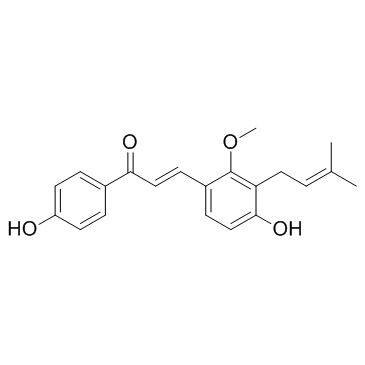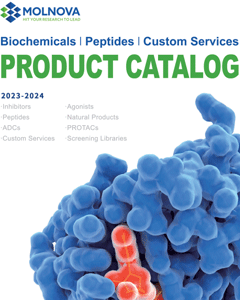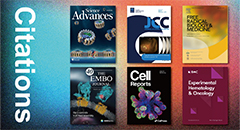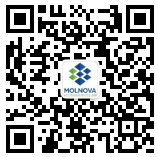
LICOCHALCONEC
CAS No. 144506-14-9
LICOCHALCONEC ( Licochalcone C | Licochalcone-C )
产品货号. M18021 CAS No. 144506-14-9
甘草查尔酮 C 具有有效的抗氧化特性,并能抑制细菌生长和细胞呼吸。
纯度: >98% (HPLC)
 COA
COA
 Datasheet
Datasheet
 HNMR
HNMR
 HPLC
HPLC
 MSDS
MSDS
 Handing Instructions
Handing Instructions
| 规格 | 价格/人民币 | 库存 | 数量 |
| 5MG | ¥3208 | 有现货 |


|
| 10MG | ¥4771 | 有现货 |


|
| 25MG | ¥7655 | 有现货 |


|
| 100MG | 获取报价 | 有现货 |


|
| 200MG | 获取报价 | 有现货 |


|
| 500MG | 获取报价 | 有现货 |


|
| 1G | 获取报价 | 有现货 |


|
生物学信息
-
产品名称LICOCHALCONEC
-
注意事项本公司产品仅用于科研实验,不得用于人体或动物的临床与诊断
-
产品简述甘草查尔酮 C 具有有效的抗氧化特性,并能抑制细菌生长和细胞呼吸。
-
产品描述Licochalcone C is an inhibitor of lipopolysaccharide-interferon-γ inflammation. It acts by improving antioxidant conditions and regulating inducible nitric oxide synthase expression. It acts as an inhibitor of recombinant human PTP1B assessed as hydrolysis of p-nitrophenyl phosphate.
-
体外实验Licochalcone C could inhibit α- glucosidase, with IC50s of <100 nM and 92.43 μM for α- glucosidase and PTP1B, respectively. It is also indicated that Licochalcone C induces T24 cell apoptosis in a concentration?dependent manner. Licochalcone C treatment reduces the levels of the anti?apoptotic mRNAs (Bcl-2, Bcl-w and Bcl-XL) and increases expression of the pro-apoptotic mRNAs (Bax and Bim). The Bcl-2 family inhibitor (ABT-737) reduces apoptosis induced by licochalcone C in T24 cells.
-
体内实验——
-
同义词Licochalcone C | Licochalcone-C
-
通路Others
-
靶点Other Targets
-
受体Antioxidant
-
研究领域——
-
适应症——
化学信息
-
CAS Number144506-14-9
-
分子量338.39
-
分子式C21H22O4
-
纯度>98% (HPLC)
-
溶解度In Vitro:?DMSO : 33.33 mg/mL (98.49 mM)
-
SMILESCOc1c(\C=C\C(=O)c2ccc(O)cc2)ccc(O)c1CC=C(C)C
-
化学全称(E)-3-[4-Hydroxy-2-methoxy-3-(3-methylbut-2-enyl)phenyl]-1-(4-hydroxyphenyl)prop-2-en-1-one
运输与储存
-
储存条件(-20℃)
-
运输条件With Ice Pack
-
稳定性≥ 2 years
参考文献
1. Zhou M, et al. Life Sciences, 2015, 132:27-33.
产品手册




关联产品
-
Cuprizone
Cuprizone 是一种铜螯合剂,可与铜 (II) 形成深蓝色铜酮络合物。 铜酮反应可用于比色测试中是否存在痕量铜。Cuprizone 可用于诱导小鼠的一些精神分裂症样行为。Cuprizone 作用于铜酶,包括 SOD1、细胞色素氧化酶和 DβH,从而导致氧化应激并增加某些大脑区域如内侧前额叶皮层 (PFC) 的 DA 水平。
-
(-)-Pinoresinol 4-O-...
(-)-Pinoresinol 4-O-glucoside is a natural product from Lonicera japonica THUNB.
-
Kuwanon E
Kuwanon E inhibited cholinesterase enzyme in a dose-dependent manner with K i values ranging between 3.1 and 37.5 μM and between 1.7 and 19.1 μM against acetylcholinesterase (AChE) and butyrylcholinesterase (BChE) enzymes, respectively.



 021-51111890
021-51111890 购物车()
购物车()
 sales@molnova.cn
sales@molnova.cn







